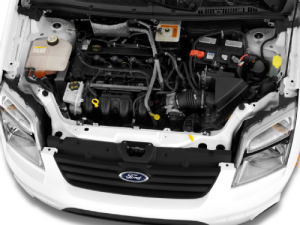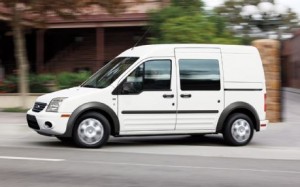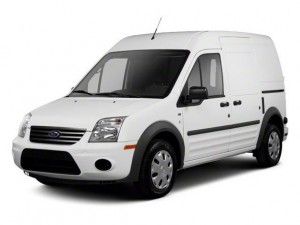 I just finished spending a week in another $40,000 minivan (2013 Toyota Sienna; see here) so it was kind of nice to spend some time in one that cost half as much. And which was half as big.
I just finished spending a week in another $40,000 minivan (2013 Toyota Sienna; see here) so it was kind of nice to spend some time in one that cost half as much. And which was half as big.
You know – like minivans used to be.
Now, Ford doesn’t call the 2013 Transit Connect a minivan. But it sure has more in common with old school minivans than the two ton, seventeen-footers that go by that designation nowadays. And not just in terms of its more modest size, either.
It is also modestly priced – and fairly easy on gas.
Of course, it hasn’t got a DVD widescreen entertainment system – and it won’t get to 60 in 8 seconds or less. But it’s ideally suited to be a low-bucks kid-hauler, which current not-so-mini-vans aren’t.
Its tall roof/large cargo (and available cargo inventory system) also make it an ideal truckster for electricians, plumbers and contractors generally.
Might be worth a look-see if you fall into any of those categories.
The Transit Connect is a kind of Mini-me jitney bus/compact-sized utility van.
Originally built for the European market – where space is tight and fuel expensive – the four cylinder-powered, front wheel drive Transit isn’t much bigger in terms of its exterior footprint than a current compact-sized sedan, but it has a comparatively huge (and tall) box with almost as much total cargo space (135 cubic feet) as a current not-so-minivan. (The much larger 2013 Toyota Sienna I reviewed last week has 150 cubic feet of total cargo space.)
The Transit Connect is available in either cargo or passenger-carrying configurations, with prices starting at $22,265 for the Cargo Van XL (no side or rear glass and just two seats for passenger and driver) and topping out at $24,040 for an XLT Premium with a second row of three-across seats and five-passenger capacity. Ford also offers a CNG (natural gas) ready version, which could be an alternative to a much more costly hybrid.
It’s a unique vehicle that doesn’t have any direct competition in the United States.
WHAT’S NEW FOR 2013
Ford added stability control to the list of standard equipment last year (2012). For 2013, the Transit carries over unchanged – with the exception of a slight across the board uptick in prices (last year’s base price was $22,035) which can be attributed to inflation and the Fed rather than to Ford.
WHAT’S GOOD
XL Cargo versions make for ideal small-business urban-suburban runabout/delivery vehicles.
XLT version could be a budget-priced alternative to a traditional minivan or crossover SUV.
CNG version could be a way to end-run high gas prices.
Cheap to buy – cheap to drive.
Factory broadband Internet access; available high-tech DeWalt electronic tool inventory management system.
Windowless base models have Stevie Wonder rearward visibility that can make the Transit unsettling to drive in heavy traffic if you’re not used to commercial-type vehicles.
UPS truck handling qualities.
Geo Metro acceleration.
Out of date four-speed automatic transmission.
Though the cargo area is capacious, maximum cargo weight is limited to 1,600 lbs.
No towing capacity.
The Transit comes standard with a 2.0 liter, 136 hp engine and four-speed automatic.
All versions are front-wheel-drive.
This layout is very similar to what you’d have found in a mid-late 1980s Dodge Caravan (which came standard with a 2.2 liter, 96 hp engine). This has its good – and bad – points.
The good: decent fuel economy; 21 city, 27 highway. This means you should be able to average low-mid 20s – vs. averaging mid-high teens in a V-6 powered not-so-mini-van. (The Sienna I had last week has a city MPG rating of just 17 – and maxxes out at 23 on the highway.)
Being a four, there are also fewer parts to service (such as spark plugs) as well as less oil, coolant and so on to replace. Plus inherently easier access to the engine. Ask anyone who has changed a transverse four’s spark plugs vs. a transverse V-6’s spark plugs. This should make the Transit cheaper to keep up – and more amenable to DIY keep up, too.
The bad: Zero to 60 takes about 12.4-12.5 seconds, so a Prius hybrid can easily outrun this thing. So can pretty much anything else. A modern minivan (any of them) is at least four seconds quicker to 60. The limited hp under the hood also limits what you can do with the Transit. It can’t, for example, carry a pallet of bricks home from Home Depot – even though the pallet load of bricks would fit inside. Most current not-so-mini-vans can pull at least 1,500 lbs. Several can pull 3,000.
The Transit can’t pull anything.
Also, the Transit’s gas mileage is not what it might be because of the old-school four-speed automatic transmission. There’s nothing wrong with it – it’s just that it’s not as efficient as the five (and six) speed automatics that are commonplace today. With a continuously variable (CVT) transmission, the Transit could probably achieve 30-plus MPG on the highway – and average mid-20s.
The available CNG Engine Prep Package is worth a mention. Order this (it’s cheap, only $315) and you’ll be able to operate on CNG – which is much cheaper on a per-gallon-equivalent basis than gasoline. How much cheaper? About a buck per-gallon-equivalent (see here for more info). CNG prices are also less volatile, in part because the US has tremendous reserves of the stuff. That’s the upside.
The downsides are: The package only includes the ugrades to the engine necessary to operate on CNG such as hardened intake/exhaust valves. You’ll still need to buy the CNG tanks (the main expense) and also have the engine computer reflashed before it’s ready to burn CNG. Also, while CNG is cheap it is also hard to find. You pretty much have to have access to a fleet refueling facility – and even if you do, your driving range will be constrained by the location of the refueling facility.
Check into all of this thoroughly before you check the box for the CNG option.
It takes a few minutes to get used to your environment inside the Transit. The roofline is much taller than even the tallest of the new “cube” vehicles (Scion xB, Kia Soul, Nissan… er, Cube). The roof extends upward from the top of the windshield by eight inches. But this is what makes the five-foot floor to ceiling height – and the Transit’s versatility as a cargo-hauler – possible.
It also gives you outstanding side visibility due to the tall side glass (assuming you order it).
There’s a storage alcove built into the upper bulkhead, above the driver’s head – just like in jitney busses of the type you may have been ferried from a hotel parking lot to an airport terminal in. Behind you (in Cargo versions) is an untrimmed, unadorned all-metal interior; no side or rear windows.
There’s no rearview mirror, either – because, after all, what would be the point?
Wagon versions do get side and rear windows – and you can order them on the lower trim Cargo version for about $200 extra.
Though it is physically a small vehicle (180 inches long and 70.7 inches wide, or just only slighter longer and wider than a Focus sedan – which is considered a compact) the Transit’s height (nearly 80 inches, vs. 58.6 for the Focus) combined with the windowless sides and rear, makes it feel bigger than it really is.
Still, once you get used to it (and learn to use your side mirrors) you find the Transit is very easy to maneuver into tight spots, such as curbside parking in busy downtown areas. It readily slots into places that would be off limits to a standard van, or even a standard-sized not-so-mini-van.
The turning radius is only 39 feet – almost exactly the same as the physically much larger Chrysler Town & Country not-so-mini-van.
Though it’s perhaps the most top-heavy looking vehicle since the Suzuki Samurai, it doesn’t feel unstable (if driven within reason), thanks to its fairly low center of gravity.
Acceleration is postal Jeep-like, but it’s enough to get around – provided you don’t mind not getting there first. Yeah, a 12-13 second 0-60 time is pretty crippled up by modern car standards, but reflect that it’s actually better than most average/v-6 powered family-type cars managed back in the ’80s.
And decent gas mileage is your payoff – though the Transit would be even better with a diesel engine under its hood. A diesel’s torque advantage at low speeds would also make it feel snappier in terms of acceleration – and probably would give 40-plus MPGs, too.
I’d rather have that than the CNG thing.
The Transit looks like a downscaled commercial vehicle, especially models painted washing machine white (like my test vehicle) without the side or rear glass. Your neighbors will think the electrician is doing some work at your place. Or maybe that you’ve opened a new catering business. And that actually might be an issue for people who live in communities with HOAs that prohibit residents from parking “commercial” vehicles outside their homes – or even in their driveways. Though legally speaking it’s not “commercial,” you still may have to wrangle with the HOA Mussolinis.
The interior, though Spartan, is well-designed for its intended purpose. Dual (manual) sliding side doors are standard; you can also access the back by a pair of hinged doors that open outward and almost fold back on themselves (225 degrees) to keep them out of your way and make it easier to load the vehicle.
Two-seater versions have a total of 135 cubic feet of cargo capacity. This is a lot of room for the size. For perspective, the biggest Kahuna of current not-so-minivans, the Toyota Sienna, only has 15 cubic feet more total cargo capacity.
And the Transit’s layout is set up for maximum usability. The 6×4 cargo floor is totally flat – and the depth from the ceiling to the floor is five feet, which means you can walk around back there, just hunched over some. Still, you can roll a motorcycle into this thing, no problem.
Try that in a standard-sized not-so-mini-van.
Do keep in mind the 1,600 lb. max payload rating, though.
There are also some unique features available in the Transit that you can’t get in any other vehicle, such as the factory-installed broadband Internet access/display with wireless keyboard and mouse that lets you check/send e-mails from the vehicle (which must be stationary for the system to work, fyi). There’s also an available DeWalt Tool Link RFID tracking system to inventory your expensive tools. It’s an expensive option, however: $925.
Passenger Wagon versions come with a second row of three-across seats, which are easy to access via either of the two sliding doors. The very low step-in height of the Transit makes getting in and out of the second row easy, even for people with limited mobility.
In fact, the Transit would probably be an ideal candidate for a handicapped conversion. There’s plenty of room for storing a wheelchair in the cargo area and getting in and out requires less stepping up/climbing over obstacles than in a conventional minivan.
If you’re contractor, you could add shelves along the interior sides of the cargo box; dealer installed bulkheads are available, too.
All trims get AC and tilt/telescoping steering wheel included as part of the standard equipment package.
THE REST
Ford did a lot to keep the Transit simple and (hopefully) low bucks to maintain as well as to buy. For example, it comes standard with stamped steel 15 inch wheels with plastic wheelcovers and disc/drum brakes. Accidentally run up over a curb (or hit a deep pothole) and you probably won’t hurt the rugged steel wheels. And if you lose a plastic wheelcover, it’s going to cost a lot less to buy a new one than the fancy trim rings on alloy wheels.
The drum rear brakes will get the job of basic transportation done – and like the steel wheels, they are simple, functional, durable and cheap when they require fixing. Drum brakes don’t have relatively fragile rotors to warp – or expensive calipers that can seize up, Just replace the shoes (typically, $40 or so) every 30,000 miles or thereabouts and usually, you’re all set.
Some reviewers mock the Transit’s four-speed automatic as ancient technology – which it is, given that most new cars come with at least five-speed transmissions and many offer six or even seven speed transmissions. But while the four-speed may not be the most modern – and while it’s true the Transit’s probably a bit less fuel efficient (and not quite as quick-feeling) as it might have been with a five or six-speed – the four-speed keeps the up-front cost of the vehicle down and (probably) this unit will cost you a lot less to rebuild/replace, should that become necessary, than the newer transmissions – which can run $2,500 or more just for a replacement unit – not counting install labor.
For small businessmen, or the Family Guy looking to pare down the cost of owning/operating a vehicle – all this is very appealing.
Plus, no one’s going to bother this thing. You can park on the street without worrying about it.
THE BOTTOM LINE
Cheap is chic again.
The Transit’s not for everyone. But there are people out there who will appreciate this little runabout for what it is – and also for what it isn’t.
Throw it in the Woods?















If only it came in manual, I’d probably be test driving one. The biggest problem with a 4-speed auto, above everything else, is that IF YOU KNEW HOW TO DRIVE A REAL CAR, and you chose to buy real cars, you could have a decent little car that doesn’t have a V8.
I have the XLT cargo version. I have a Harmar platform lift so I can take my Hoveround Power Chair and go out shopping. I would like to have power sliding doors but I can close the side door using a golf club shaft that I modified for the purpose. It would nice if a station wagon style rear door was an option. All and all I am pleased with the vehicle and average about 22 to 23 MPG.
Eric short of the CNG tank, is all the associated hardware required to run on natural gas such as regulator plumbing and injectors for CNG included. Natural gas could play a huge part in the transportation sector for America and the rest of the Planet. Thanks for looking at this aspect.
My understanding – based on what Ford has in the media kit they provide journalists – is that the engine is set up to handle CNG but the buyer has to acquire (and hook up) the tanks. I assume the plumbing from the tanks to the engine is in the car – but it might not be. Ford was not clear on this point. I’ll drop my contact a line and see whether he can clear this up for us.
Hi Eric. Any update from your contact on this subject.
Hi Ray,
Yes (and here’s a link to Ford’s PDF: https://docs.google.com/viewer?a=v&q=cache:kL1kMY8JiYUJ:media.ford.com/images/10031/2013_TransitConnect.pdf+2013+Ford+Transit+what%27s+needed+to+convert+to+natural+gas?&hl=en&gl=us&pid=bl&srcid=ADGEEShbrnj32Z4wbDE0AigkMS43ftA0LKXaiQqvT69wpJF9ld8AKtofTy3K3ey53Xd8B-eFSpUo71fCkEWMOyB8bbna4KiErCAjvwrG_xyyeWj3hSlESTKcIpQfIedAfJRwNQRmEqFD&sig=AHIEtbQ3rbrBw4EMBlaxrnL8EYFrtS_WGA )
Basically, as I understand it, the vehicle is “prepped” for conversion to CNG. That means the engine has been set up to operate on CNG, but the actual plumbing – tanks and lines – must be done by the owner. Ford does not install the tanks or the lines.
I’ve tried to find a ballpark price quote but so far haven’t found anything specific. My best guess – based on what similar conversions cost in the past – would be around $2,500.
Thanks Eric.
Np, Ray – hope it was at least somewhat helpful.
FYI: I gather that Ford will introduce a diesel-optioned Transit at some point during model year 2013….
In a way, I guess “cubic feet are cubic feet.” But having all that area in a vertical dimension seems to offer less utility than a more lateral space. Clearly, this configuration will have its uses in some applications. However, it seems like such a limited niche vehicle that it doesn’t make me much more excited than a new dump truck would.
I’m seeing a fair number in my area – and personally, I could see having one myself. It’s a lot easier (and more secure) to load a motorcycle into the Transit than it is to tie one down in the bed of a conventional pick-up truck!
I just wish you could get it with a small diesel engine and a manual transmission….
I think its a lousy move to replace the econoline van with the transit connect. Having it in addition to the econoline, which can tow/haul/diesel/aftermaerket 4×4 conversion/etc makes some sense. But ‘cmon the econoline is all RE and a cash cow for Ford. I dont get it….
I do –
The Econoline’s a liability, CAFE-wise. The 35.5 MPG mandate (and the one after that, up to 50-plus MPG) is going to change the automotive landscape in ways that few can appreciate.
The van that will ultimately replace the Econoline (E-series) in the US is the Transit, not the TransitConnect tested here. These similar names have caused confusion.
The larger Transit has been Ford’s bread-and-butter large van in Europe for decades and is about the size of the Sprinter. The change is part of Ford CEO Alan Mulally’s efforts to reduce the sheer number of vehicle platforms to save $$$.
We’ll have the small TransitConnect and the large Transit here. My hunch is that one of these will eventually change its name for the US market.
The E-series, in my view, is horribly obsolete, especially if the use is strictly commercial. And that is one of the changes I foresee with the new fuel regulations: new light trucks and vans will increasingly be mainly for commercial use, not for use as personal vehicles in place of normal cars. The commercial stuff simply won’t be that attractive to most people for personal use.
(That doesn’t hurt my feelings all that much. More and more the geopolitics of fuel supply should strongly encourage us to make more rational vehicle choices, especially when the purpose of the vehicle is little more than to haul our butts around. Note how many pickups and SUVs are in those long gas lines in the areas of New York and New Jersey that Hurricane Sandy hit.)
How about that! Ford charges MORE for the passenger version than the cargo version, even though you buying the passenger version saves Ford the expense of having to rip out all the seats and interior and replace the window glass with blank steel panels.
See, the Transit is built in Turkey, with seats and interior carpet, to get past a import tax on “trucks”
Then Ford PAYS people to rip out the seats and interior and toss it all in a dumpster.
So by buying the passenger version you;re saving Ford at least $1000 but Ford thanks you buy charging you more.
As usual from Ford we get yesterdays news, in Europe they sell a turbo diesel 5 speed version.
As I understand it the cargo versions imported with seats as passenger vehicles don’t have fully trimmed interiors, just some cheap seats to get around the tax.
Agree 100 percent on the diesel – but this isn’t Ford’s fault. It’s Uncle’s. In Europe, diesels abound – from virtually every major car company. Why don’t they sell those models here? The government, is why. Government regulations (emissions) as well as government screwing with diesel fuel has made it (until recently) very hard to “50 state” certify a diesel passenger car for sale over here. So the car companies just don’t bother with it.
As usual. This is what the US Government allows its nitwit drivers to have – a shit version of a European innercity work truck. Instead of fitting the 1,8L Diesel and 5 speed gearbox, Start/Stop and Regeneration Systems, America gets a gas motor with a lousy transmission. So instead of burning 6L/100Km (39MPG), it sucks up 11,2 (21 city) and 8,7L/100Km (27 highway). Plus, the mirrors and lighting are worse. What a pathetic state of automobile affairs.
Nice review. This van reminds me of the Mitsubishi 3000 series vans.
Didn’t Chrysler/Benz have a similar vehicle a few years back? I think it was called Sprinter?
Thanks!
The Sprinter’s a bit larger – this one’s got about the same footprint as a compact sedan. I wish they offered it with a five-speed manual, though.
But overall, a useful little beast. It does 90 percent of what I need my compact pick-up to do and has some attributes the truck does not – such as the ability to roll a motorcycle into the back and have it secured from the elements.
I could see buying one of these used a few years from now for six or seven thousand bucks…..